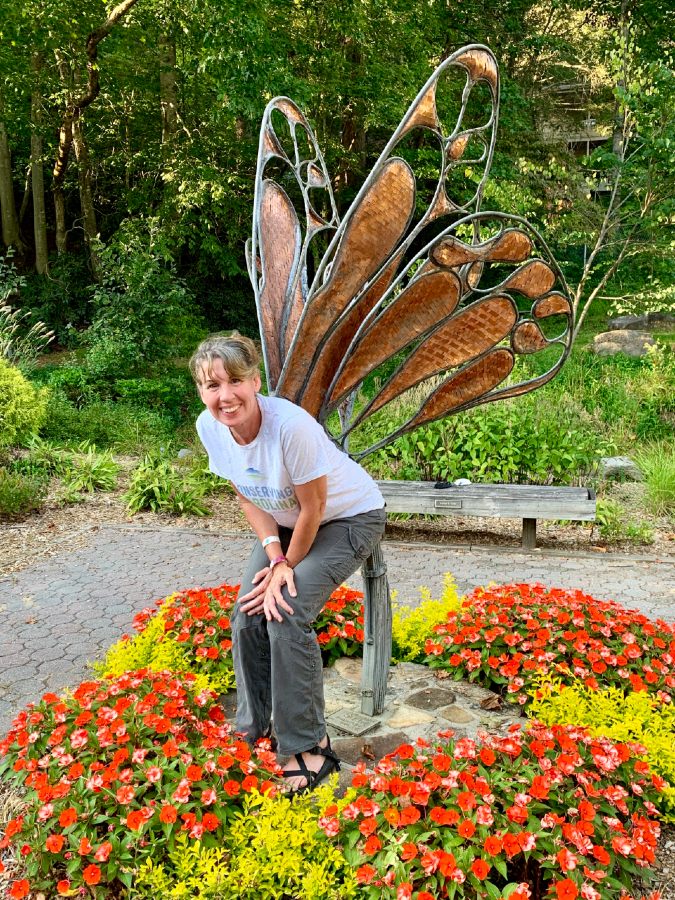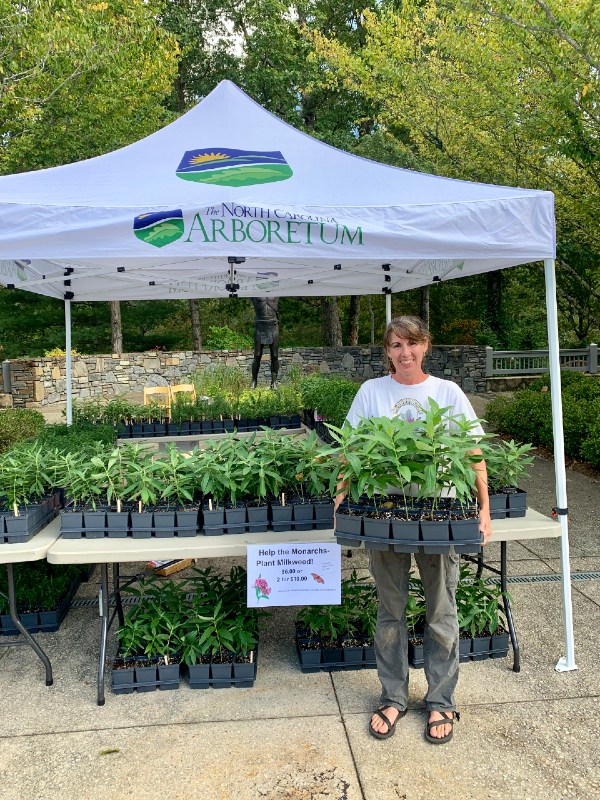If You Plant It, They Will Come
Educator and farmer Kim Bailey raises plants for butterfly gardens.

When Kim Bailey was starting out as an environmental educator in Georgia, she noticed that kids thought nature was a place where you went on field trips. “Nature was a place you had to get on a bus and go visit,” she says, “and then you came back to where you lived, which wasn’t nature.”
What if they could go right outside their door and see that they were in nature—sharing space with wild, living things? Kim started to focus on creating outdoor classrooms at schools. As part of that, she planted her first milkweed seeds.
When she put those milkweed plants outdoors, she says, a monarch butterfly must have laid eggs on them the very first day. Because, soon after, when she brought her plants to a workshop on how to use monarchs in the classroom, there were colorful, striped caterpillars munching on the leaves.
A monarch expert was giving a slide presentation. Meanwhile, one of Kim’s caterpillars had dangled from a leaf and curled into a J-shape.
“All of a sudden the caterpillar starts to pupate,” Kim remembers. “It’s shedding its skin and forming its chrysalis, right there, in real life. So the presenter said, ‘Stop the slides! Everybody gather around!’
“All the teachers, that’s the first time they ever saw the metamorphosis. And apparently, it also changed me because I got totally hooked on it!”

Lost Magic
Twenty years later, Kim is the owner of Milkweed Meadows Farm in Fruitland, N.C. On farmland that’s been in her husband’s family for generations, she grows milkweed, pawpaw, passionvine, and other pollinator-friendly plants. She sells at plant sales and supplies seeds for Sow True Seed. As a volunteer, she coordinates Bee City USA – Hendersonville, a program to create healthy habitats for all pollinators. On vacation, she travels to Mexico with her friends to see the monarchs overwintering in their mountain sanctuaries.
“I feel lucky because what I do for a living, what I do as a volunteer, and what I do for fun, it’s all the same thing,” she says.
Kim grew up in Aiken, S.C., where she enjoyed playing outside. She went into environmental education because she saw that many kids don’t have the same opportunities she did to experience nature.
Kim, in turn, didn’t have some of the opportunities her parents had. Her father tells stories about growing up in Florida, how he took a lifeguarding test in a clear, spring-fed sinkhole so deep that no one even knew how far it went. Kim wanted to swim in this magical pool—but the sinkhole was gone, flooded over for development.
“I just remember feeling so sad about that,” she says. “And to think that kids today may not have the same chances I did to run around in the backyard or make mudpies. I don’t think it has to be that way.”
What’s Your Environmental Handprint?
Monarchs could go the way of that clear pool—just a story we tell our children. Once commonplace, monarchs are now in a sharp decline. In just two decades, eastern monarch populations plummeted by 90%. One likely reason is the loss of milkweed throughout North America, due to factors that include land development and increased use of herbicides on agricultural land. Milkweeds are the only plants that monarchs will lay eggs on and the only plants their caterpillars will eat.
Climate change also endangers monarchs. According to National Geographic, higher carbon dioxide levels are changing the chemical composition of milkweed and warmer temperatures are shifting breeding grounds further north, elongating their already epic migration.
However, in recent years, there’s been a positive trend. Scientists have seen more monarchs overwintering in Mexico. According to Monarch Watch, the population in the 2018-19 season was up nine-fold from the precarious low of the 2013-14 season.
Part of this good news could be due to the many gardeners who are replacing lost milkweed by growing it themselves. That includes the people who buy Kim’s seeds and plants and the Bee City USA volunteers who create pollinator gardens at schools and public spaces.

Kim says, “I always remember hearing about the environmental footprint—what is your impact on nature? It’s such a negative way to look at it. There’s an alternative to that called an environmental handprint—what are you doing to lend a helping hand? How are you having an impact, but a positive one? To me, gardening for pollinators is all about that.
“Planting a seed is one of the most hopeful things you can do. And when you get the plant and the butterfly actually comes and lays her eggs on it or uses it for nectar, you see, ‘It worked!’ You’re asking people to do something that helps the environment but you’re also giving them a way to experience joy and beauty. I think that’s a big part of why this movement has caught on,” Kim says.
“Everyone wants to do something to help, but it’s a happy thing that you’re doing and it doesn’t feel like a sacrifice. It’s contagious. It’s an empowering thing and it’s a joyful thing.”
Many Colored Wings
Five years ago, Kim started moving her work with butterflies from the classroom to the farm. She and her husband, Jeff Bailey, moved to the family farm in Henderson County, which goes back to his great-great-grandparents. “Now, instead of a dairy farm, it’s a milkweed farm,” Kim says.

She removed invasive plants and adopted a meadow where milkweed was already thriving. She planted an orchard of pawpaws and a tunnel of passionvines—two host plants for butterflies that also produce delicious fruit. She converted the milkhouse into a potting shed and greenhouse. She also grows an abundance of nectar-rich flowers, including annuals like zinnias and cosmos as well as native perennials such as coreopsis, purple coneflower, black-eyed susan, mountain mint, blazing star, joe pye weed, ironweed, aster, goldenrod, swamp sunflower, and blue mistflower. As caterpillars, many species are highly specialized—like monarchs, which eat nothing but milkweed leaves. However as butterflies, they gather nectar from a wide range of blossoms.
In June, Kim says, the farm is full of bright wings. Pipevine swallowtails flutter by in jewel blue. Bright yellow sulphurs, brilliant orange monarchs, and spotted brown buckeyes bob through the air. All kinds of fritillaries and swallowtails land on their flowers. In fact, one summer afternoon, Kim went out and netted about 25 different species of butterflies for a demonstration (afterwards, they all flew free again.)
How to Grow a Butterfly Garden
If you want to bring more butterflies to your home, Kim says you can think of “2-2-2.” You get started with two kinds of perennial plants, two kinds of trees, and two kinds of vines.
For perennials, first you need milkweed for monarchs. To help the butterflies, choose locally native varieties, which include common milkweed, swamp milkweed, or butterfly weed. (See tips from Kim on how to grow milkweed.) Your other plant could be parsley, dill, or zizia (a.k.a. golden alexander.) Those attract black swallowtails.
For trees, you need pawpaws, the host plant for zebra swallowtail. Either spicebush or sassafras, as hosts for the spicebush swallowtail, would be other good choices.
For your two vines, you could plant pipevine to host pipevine swallowtails and passionvine to host two different kinds of butterflies: gulf fritillaries and variegated fritillaries.
If you plant it, they will come,” Kim says. And that goes beyond butterflies. Your plants will nourish bees and other pollinators. With more insects, animals like frogs and bats find more to eat. Birds harvest from the abundance of caterpillars to feed their nestlings.
Then, you don’t have to drive anywhere to visit nature. It’s where you live.
Kim also points to the Hendersonville Tree Board’s Recommended Landscape Species List (PDF) as a good source of ideas for local pollinator plants.
This article is written by Rose Jenkins Lane as part of our our monthly Stories of the Land series which runs in the Hendersonville Times-News. These stories explore people’s connection to the land and the ways they give back to the places they love.